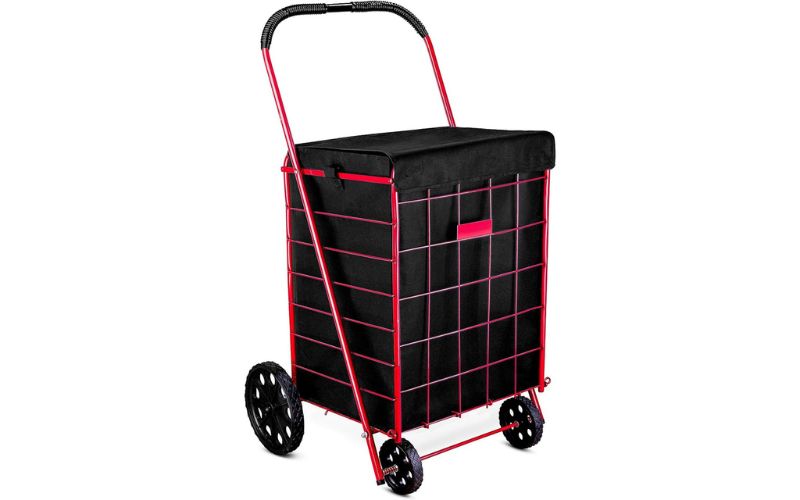When choosing between a shopping cart liner and plastic bags, you weigh sustainability against convenience. Cart liners, crafted from durable materials like 600D Oxford Polyester, offer an eco-friendly, long-lasting alternative to single-use plastic bags. They come with features like zipper closures and pockets for easy organization. On the other hand, plastic bags are ubiquitous and often free at the point of use, but their environmental and long-term financial costs are substantial. So, what’s really at stake when you make your choice? You might find the answer isn’t as straightforward as it seems.
Add style and convenience to your shopping trips with our durable, colorful Shopping Cart Liners – Shop Now!
Environmental Impact
Reusable shopping cart liners outshine single-use plastic bags when making environmentally conscious choices. Plastic bags have a notoriously short lifespan and contribute greatly to soil and water pollution because they’re non-biodegradable. Opting for a reusable Waterproof Shopping Cart Liner can make a big difference in reducing your environmental footprint.
- Once discarded, single-use plastic bags persist in the environment for hundreds of years, harming wildlife and ecosystems. In contrast, non-wovenpolypropylene and cotton reusable bags have far lower environmental impacts. These materials aren’t only durable and less harmful to produce and dispose of.
- You can significantly reduce plastic waste by consistently using and properly maintaining your reusable shopping cart liner. This small change in your shopping habits can lead to massive environmental benefits. A bag must be used multiple times to offset its production impact, but the long-term benefits are undeniable.
- For a greener future, choosing reusable bags over single-use plastic is essential. Rights Reserved or not, this choice supports global efforts to reduce overall environmental impacts and fosters a healthier planet for future generations.
Material Durability
When pondering material durability, you need to weigh strength and flexibility. High-density trash liners are great for light-duty tasks, but low-density bags excel in puncture and tear resistance, making them perfect for handling pointy objects.
Meanwhile, shopping cart liners made from 600D Oxford Polyester offer robust durability, with features like zipper closures ensuring secure containment.
Strength and Flexibility
Shopping cart liners, crafted from robust 600D Oxford Polyester, offer exceptional strength and flexibility, making them perfect for handling heavy groceries and laundry loads. Their material durability guarantees that you can depend on them for long-term use, reducing the need for single-use plastic bags. Unlike plastic bags, which often tear or break under heavy weight, cart liners are designed to withstand the rigors of repeated use without compromising their integrity.
When you’re lugging around heavy items, the last thing you want is a bag that can’t hold up. Shopping cart liners excel in this aspect, providing the strength and flexibility to manage even the heaviest loads. You can confidently pack them with groceries, laundry, or other bulky items without fretting about them giving out.
Additionally, many shopping cart liners have zipper closures, offering added security and convenience. This feature guarantees that your items stay in place and are easily transported.
Puncture and Tear Resistance
Beyond strength and flexibility, shopping cart liners' impressive puncture and tear resistance are another vital aspect. When contemplating durability comparisons, shopping cart liners often outperform plastic bags. Low-density liners are thicker and offer higher puncture resistance, making them ideal for carrying sharp or heavy items. This material flexibility ensures that the liner won’t easily tear or puncture even when subjected to heavy-duty use.
On the other hand, while strong and stiff, high-density plastic bags may lack the same level of puncture resistance. They have good tear resistance and excellent weight capacity, but their rigidity can be a drawback when handling sharp objects. This makes them less suitable for heavy-duty use compared to low-density liners.
When choosing between a shopping cart liner and plastic bags, it’s vital to consider the specific needs of your shopping habits. If you often transport heavier or sharper items, a low-density shopping cart liner with better puncture and tear resistance will likely be more durable and reliable. In contrast, high-density plastic bags might suffice for lighter, less demanding tasks. This durability comparison highlights why material flexibility and puncture resistance are crucial in making the right choice.
Cost Comparison
Although shopping cart liners may require a higher initial investment than single-use plastic bags, they can be more economical in the long run. When you compare the cost-effectiveness, the upfront investment in a durable shopping cart liner might seem steep. However, the long-term savings become apparent over time as you no longer need to purchase plastic bags continually.
Here’s a quick comparison:
| Aspect | Shopping Cart Liner | Plastic Bags |
| Upfront Investment | Higher | Lower |
| Long Term Savings | Significant | None |
| Environmental Benefits | High | Low |
| Value Added Features | Waterproof, sturdy | None |
| Durability Benefits | Long-lasting | Single-use |
Opting for a reusable shopping cart liner can lead to substantial savings. Not only are you cutting down on recurring costs, but you’re also contributing positively to the environment. The environmental benefits of reducing plastic waste can’t be overstated.
Additionally, many shopping cart liners have value-added features like waterproofing and sturdy construction. These durability benefits ensure that your liner will last through many shopping trips, making your initial investment well worth it.
Maintenance and Care
Taking proper care of your shopping cart liner ensures it remains functional and hygienic for many uses.
- Start by regularly cleaning it with mild soap and water to prevent dirt buildup. Once washed, air dry the liner thoroughly to avoid mold or mildew formation. These simple cleaning methods guarantee your liner stays fresh and prepared for your next shopping trip.
- Inspect your liner for any tears or damage frequently. Promptly fixing small issues can prevent them from becoming larger problems, helping to extend the lifespan of your liner. Basic repair techniques, like stitching up minor tears, can go a long way in maintaining its effectiveness.
- Store your shopping cart liner in a dry, cool place when not in use. Proper storage options will protect it from unnecessary wear and tear, contributing to its durability.
- Always follow the manufacturer’s care instructions for specific maintenance guidelines. Adhering to these recommendations can also impact your product warranties, ensuring you get the most out of your purchase. You’ll enjoy a long-lasting, reliable shopping cart liner and a more sustainable shopping experience by taking these steps.
Conclusion
Choosing shopping cart liners over plastic bags positively impacts the environment while enjoying greater durability and convenience. These liners are made to last and come with handy features like zipper closures and compartments. They might cost a bit more upfront, but you’ll save money over time and help reduce waste. With easy maintenance and high consumer satisfaction, switching to reusable liners is a smart, sustainable choice.



